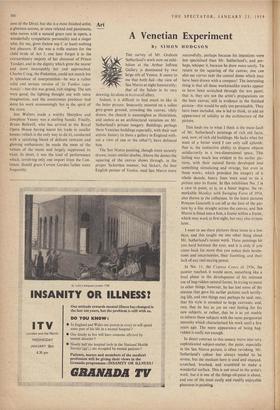Art
A Venetian Experiment
By SIMON HODGSON THE survey of Mr. Graham Sutherland's work now on exhi- bition at the Arthur Jeffress Gallery is dominated by two large oils of Venice. It seems to me that both fail—the view of San Marco at night honourably; that of the Salute in its very drawing, let alone in its overall effect.
Indeed, it is difficult to find much to like in the latter picture. Insecurely moored on a sullen - grey-green ground, crowding the canvas, vilely drawn, the church is meaningless as illustration, and useless as an architectural variation on Mr. Sutherland's private imagery. Buildings, perhaps these Venetian buildings especially, with their vast artistic history (is there a gallery in England with- out a view of one or the other?), have defeated him.
The San Marco painting, though more securely drawn, raises similar doubts. Above the domes the squaring of the canvas shows through, in the proper Sickertian manner, but Sickert, the best. English painter of Venice, used San Marco more successfully, perhaps because his intentions were less specialised than Mr. Sutherland's, and per- haps, whisper it, because he drew more surely. To return to the squaring of the canvas; one can also see curves near the central dome which may have been drawn with a compass! The interesting thing is that all these workmanlike marks appear to have been scratched through the wet paint; that is,' they are not the artist's preparations on the bare canvas, still in evidence in the finished picture—this would be only too permissible. They have been included, one is led to think, to add an appearance of solidity to the architecture of the picture.
This leads me to what I think is the main fault of Mr. Sutherland's paintings of rich, old faces, and, now, of rich old buildings. He lacks what for, want of a better word I can only call aplomb; that is, the instinctive ability to dispose objects satisfactorily in a two-dimensional space. This failing was much less evident in his earlier pic- tures, with their natural forms developed into something stimulating and strange, but even in those works, which provided the imagery of a whole decade, heavy lines were used to tie a picture into its frame. In this exhibition No. .3 is a case in point, as is, to a lesser degree, the re- markable Monkey with Swinging Form of 1954, also shown in the collection. In the latest pictures Princess Gourielli is cut off at the foot of the pic- ture by a line straight across the canvas, and San Marco is fitted into a box, a frame within a frame, which may work at first sight, but may also irritate later.
I went to see these pictures three times in a few days, and this taught me One other thing about Mr. Sutherland's recent work. These paintings hit you hard between the eyes, and it is only if you come back for more that you notice their hesita- tions and uncertainties, their fumbling, and their lack of any real staying power.
In No. 11, the Cypress Cones of 1956, the painter reached, it would seem, something like a final phase in the development of his intimate use of hag-ridden natural forms. In trying to move to other things, however, he has lost some of the tension that gave his earlier pictures such terrify- ing life, and two things may perhaps be said; one, that his style is unsuited to large canvases; and, two, that he has as yet no real feeling for his new subjects, or rather, that he is as yet unable to inform these subjects with the same purgatorial intensity which characterised his work until a few years ago. The mere appearance of being hag- ridden is really not enough.
In direct contrast to this uneasy move into very sophisticated subject-matter, the paint, especially in the San Marco picture, is often ravishing. Mr. Sutherland's colour has always tended to be severe, but the medium here is used and enjoyed, scratched, brushed, and scumbled to make a wonderful surface. This is not usual in the artist's work, but it is one of the things oil-paint is about, and one of the most easily and readily enjoyable pleasures in painting.










































 Previous page
Previous page